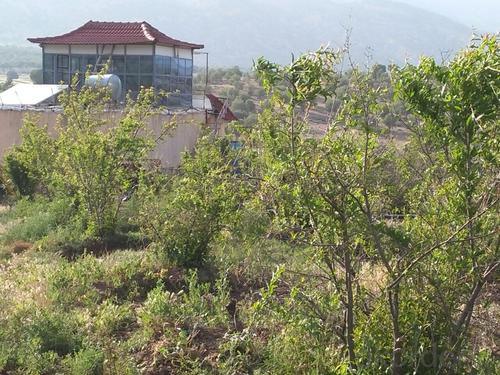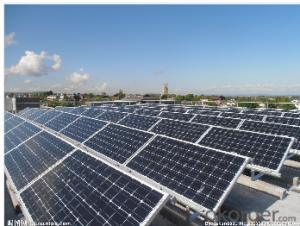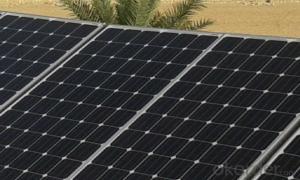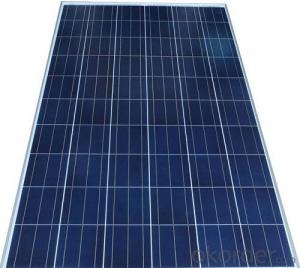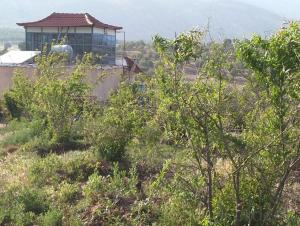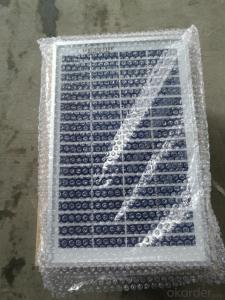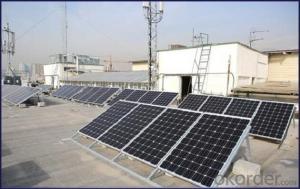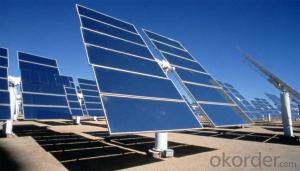CE and TUV Approved High Efficiency 50W Mono Solar Panel with Solar Panels Lightning Protection
- Loading Port:
- Shanghai
- Payment Terms:
- TT OR LC
- Min Order Qty:
- 10000 watt
- Supply Capability:
- 20000000 watt/month
OKorder Service Pledge
OKorder Financial Service
You Might Also Like
Specification
Product Description:
1.Structure of Polycrystalline Silicon Solar Panel
I. High efficiency crystalline silicon solar cell. Even if under the weak light, the solar module can produce maximum power output.
II. Tempered glass (toughened glass): Anti-reflecting coating and high transmission rate glass increase the power output and mechanical strength of solar module.
III. EVA and TPT: Using high quality EVA and TPT to prevent destroying and water.
IV. AI frame: Without screw, rner connection. 6 holes on the frame can be installed easily.
V. Junction box: Multi function junction box with water proof.
VI. Long lifetime: ≥25 years; Less power decrease.
VII. Good performance of preventing from atrocious weather such as wind and hails.
VIII. Resisting moisture and etching effectively, not effected by geology.
IX. The certificate issued by international authority: UL, TUV, IEC, CE.
2.Characteristics
1)Manufactured according to international quality and Environment Management
System (ISO9001, ISO14001)
2)High efficiency crystalline silicon solar cells
3)High transmission Iow iron tempered glass, strong mechanical resistance
4)Anti-ageing EVA and excellent anti-climate back sheet
5)Anodized aluminum frame improves load resistance capabilities for heavy wind loads.
6)Standard waterproof junction box
7)High endurance to different weather
8)Good and friendly package with less transportation and storage space.
3.Warranty
1)10 years limited manufacturing warranty
2)10 years for 90% of warranted minimum power
3)25 years for 80% of warranted minimum power
4.The Pictures of Solar Panels
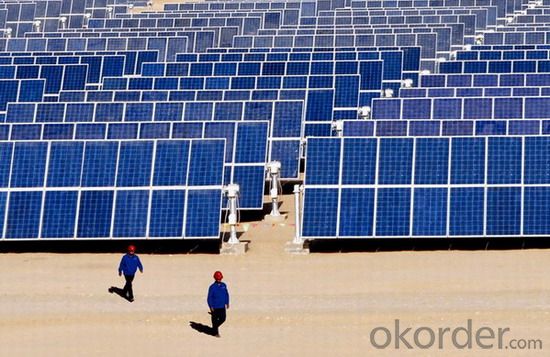
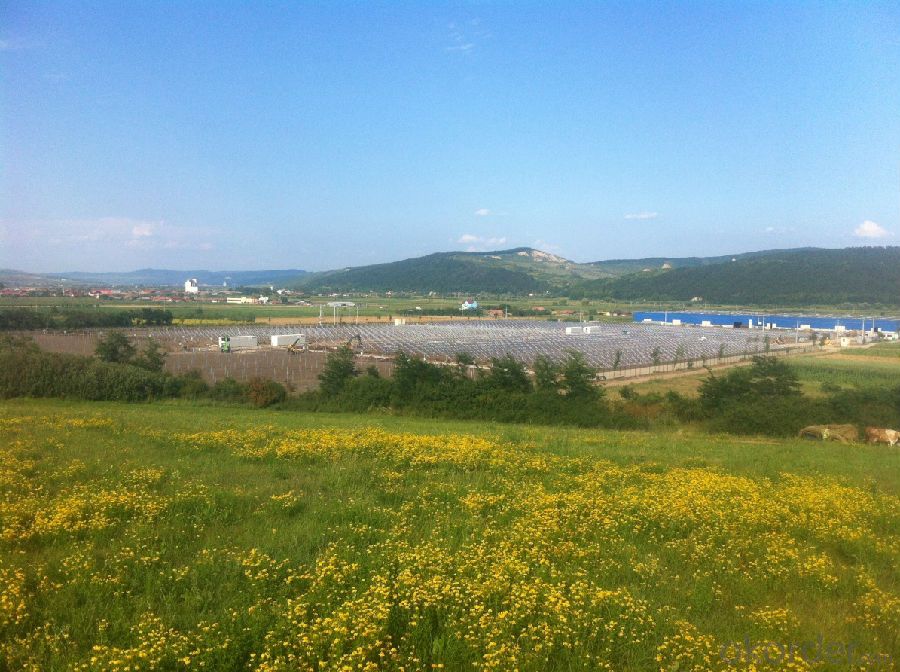
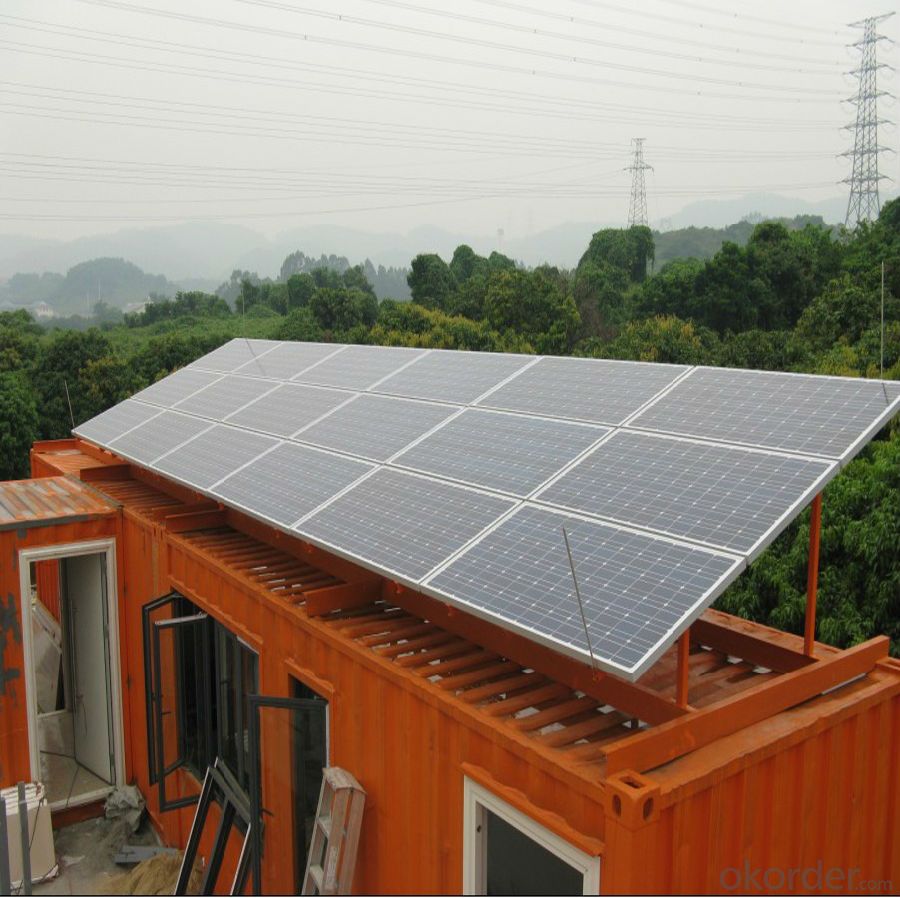
5. Production Flow
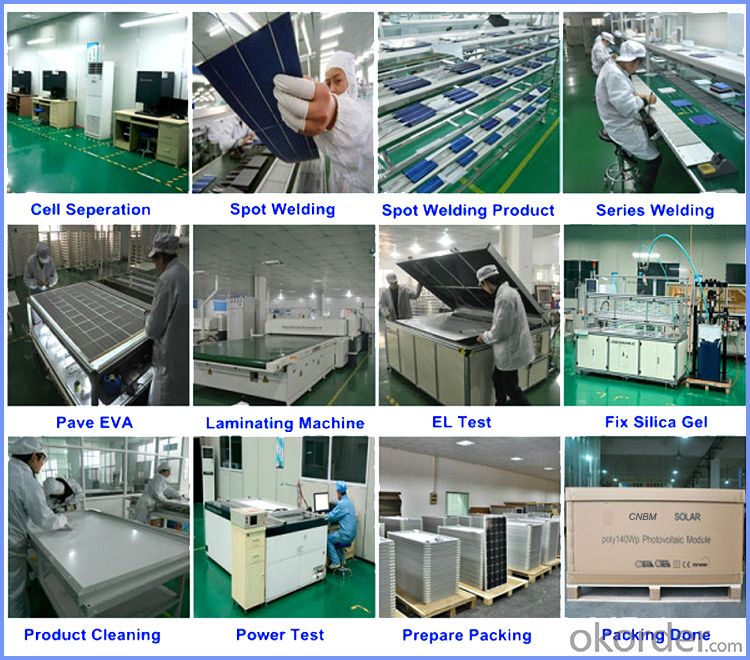
6. Packing Details
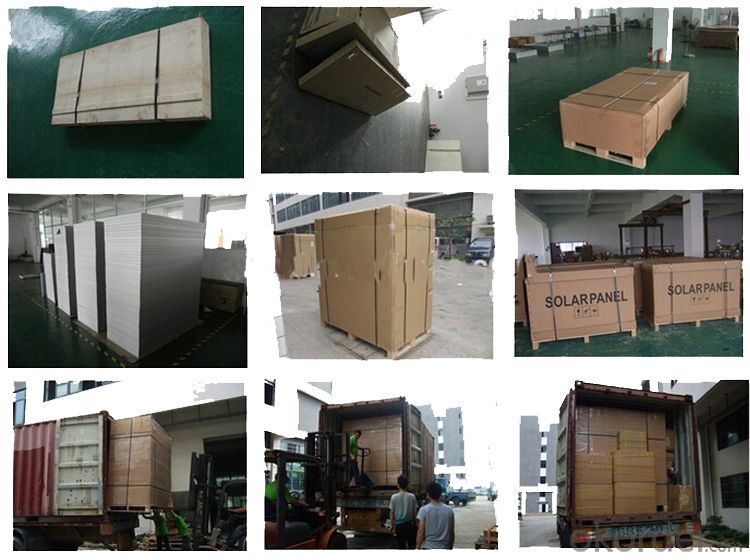
7. Use For
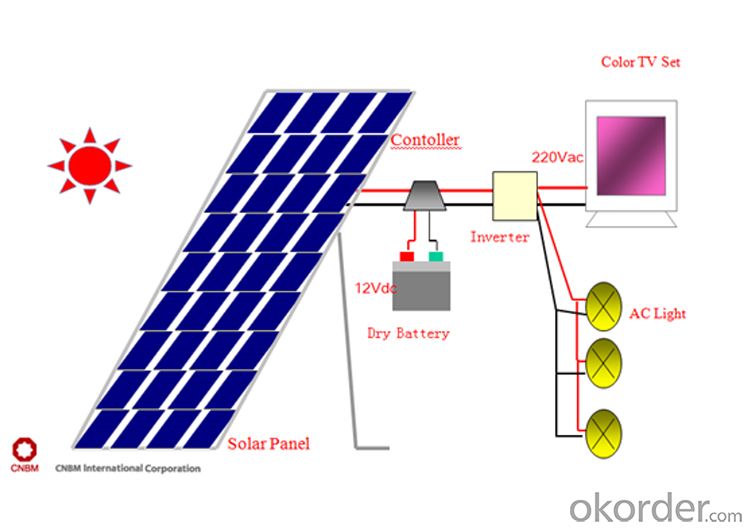
- Q: I am searching for producers or distributors of solar panels. Thanks!
- There are ton's of distributor around that can provide you a cheap solar panel that didn't came from China. Expand your knowledge and learn from a renowned solar company about the Best Solar Panels. Visit our site and contact us today!
- Q: Are there any fire risks associated with solar panels?
- Yes, there are fire risks associated with solar panels, although they are relatively rare. The main risk factors include faulty installation, damaged wiring, and electrical malfunctions. However, adherence to proper installation standards, regular maintenance, and the use of high-quality equipment significantly mitigate these risks.
- Q: i dont wanna buy a solar panel becuase its too exspensive, i dont want use technical stuff i want to use every day materiels, but i need to know asap plzzzz.
- Solar panel is a sheet of highly expensive, purest Silicon manufactured in a factory of exceptional killingly stringent specifications. You can't do that as a cottage industry, at least the material.
- Q: I've been thinking and I'd like to have solar panels installed on my roof at some point to help reduce our electricity consumption- but I live in IL and in the winter it frequently snows. Is there such a thing as heated solar panels so they don't get coated w/ice or snow? Are solar panels even a feasible option in IL? Thank you, Anna
- With state incentives that rank behind only a few states (such as the ones typically associated with solar like Florida and California) somebody definitely thinks solar is right for Illinois. (source is first site below) As for the ice and snow the typical strategy is to have a tilt that allows for only limited accumulation and still has good orientation to the sun. This is frequently talked about in articles in the magazines Homepower and Solar today. Homepower has a site online and some items are free (2nd site) Good Luck
- Q: How do solar panels affect property value?
- Solar panels can have a positive impact on property value by increasing the overall value of a property. Studies have shown that homes with solar panels tend to sell for a higher price compared to similar homes without solar installations. The energy savings and potential income from selling excess electricity to the grid can make a property more attractive to buyers, leading to a higher selling price and increased property value.
- Q: Does San Francisco get enough sunshine to really make solar panels a viable option for creating a self-supporting home? Certainly a wind turbine would be a good source of energy, but what about solar panels? Does S.F. get enough sunshine to justify using solar panels? It's overcast a lot in the Bay Area, are there any solar panels better than others for a climate like this?
- PV Solar panels all work the same. There aren't any climate specific ones. There is enough sun in San Francisco to produce energy using solar panels however, the the same panels located in a sunnier area will produce more energy. Depending on the size of your system, you will probably need a few more panels than an area that receives more sun to produce the same amount of energy. But they will still produce energy, even on overcast days. The solar installers will make all the calculations to determine what size system you will need to produce as much energy as you want. In California, you don't want to produce more than you consume in a 2 month period because currently, you are not able to sell your excess credits back to PGE after your 2 month cycle. Your system will cost more to produce the same amount of power than my system because I have less overcast days than you do. You will have to make the decision if the cost is worth your while. I expect my system to be totally paid for in around 8-9 years, working in the cost of inflation for electricity. After that, I will be paying nothing for electricty for as long as I stay in my house.
- Q: China is building solar panels and have been for years. That is the most abundant energy in the world. My nieghbor has two panels on his roof and he actually sells energy back to the electric company. These panels cost about $30,000. each, because we don't produce them here on that level.If we did, that price would drop drastically. Other alternatives are also available. Drilling for oil will no change anything. Once you give the oil companie the go ahead, the will focus on that and the alternatives won't be developed any farther. We will be right back here in about 0 years. The price will not go down anyway. So why not switch half of our fuel to alternatives?
- Solar voltaic panels are not 30,000 dollars each, a good panel, 24.4Vmp, times 95 watts, is about 900 dollars. Solar electric generation, makes sense, not because of the myth that the energy transmission companies 'buy' the energy you produce in excess (energy companies, zero out the balance at the end of the year, so that it only makes sense to design a system that equals your needs, not exceeds them). Solar electrical generation, is the future of energy freedom, but the powers that be, do not have yours' and my economic freedom in their portfolio. They are actively pursuing the globalization, to push down the working class, to the 'post industrial age', where the working classes, can once again, be relegated to serfdom, while the super rich, drink DOM, and watch us toil in the sun.
- Q: I live in a higher LATITUDE so in the winter months, there is a limitation in the amount of sunlight available, but will this impediment restrict the ability of solar panels to function due to the lack of sunlight involved?
- Solar panels work in sunlight, so obviously the more sunlight, the more power. However, ironically, solar panels don't like heat, so they work better in the cold. Higher altitudes often have more sunlight, due to less crud in the atmosphere, and are often colder than lower altitudes, so you will often get better performance in higher locations. We have solar systems working in every continent in the world, including near both the north and south pole.
- Q: Can solar panels be installed on waste treatment plants?
- Yes, solar panels can be installed on waste treatment plants. In fact, many waste treatment plants are increasingly adopting solar energy systems to reduce their reliance on traditional energy sources and lower their carbon footprint. Solar panels can be installed on the rooftops or open land areas of these plants, providing a sustainable and renewable source of electricity for their operations.
- Q: The inverter I am using gets the required 2 DC volts from the solar panel, but fo some reason it just won't output the 0 AC voltage. When the inverter is hooked to a car battery, it works just fine off the same 2 DC rating. Help me out please...
- There could be a couple of reasons why it isn't working. First, 2V panels actually put out a considerably higher voltage because it is presumed that they will be used to charge a 2Vdc battery. That requires applying a voltage greater than 2Vdc, and usually there is a solar controller that regulates the solar power to the battery. It also has a voltage drop. Look at the first reference reference, and you will see these values for a particular panel: Voc: 2.6V (open circuit voltage) Vmp: 7.2V (voltage at maximum power point) Voc is the voltage the panel produces under standard sunlight and temperature conditions (25°C), with no load applied. As load is applied, the voltage drops (see reference 2). Power is the product of current times voltage, so at one set of conditions (namely at Vmp) maximum power is available from the panel. Your inverter might not be working for either of two reasons: ) it has input protection circuitry that locks out operation when it senses an overvoltage, as in the 2.6V open circuit voltage, or 2) the panel does not produce enough current and the voltage from the panel collapses under excessive load. For example, if you load your inverter to 20W, then nominally the 2VDC input to the inverter must supply 20W/2V/eff = 0A/eff Assuming the inverter has an efficiency of 80%, the input current required is: 0A/.8 = 2.5A A solar panel operating at maximum power would need a rating of about: 2.5A x 7.2V = 25W Is your panel that big? The other option, as mentioned by others, is to charge a battery that runs the inverter. Other nuances: Voc increases as temperature decreases. Sunlight intensity varies (obviously), so the panel may produce less than rated power. The power specifications often are printed on the back side of the panel.
Send your message to us
CE and TUV Approved High Efficiency 50W Mono Solar Panel with Solar Panels Lightning Protection
- Loading Port:
- Shanghai
- Payment Terms:
- TT OR LC
- Min Order Qty:
- 10000 watt
- Supply Capability:
- 20000000 watt/month
OKorder Service Pledge
OKorder Financial Service
Similar products
Hot products
Hot Searches
Related keywords


